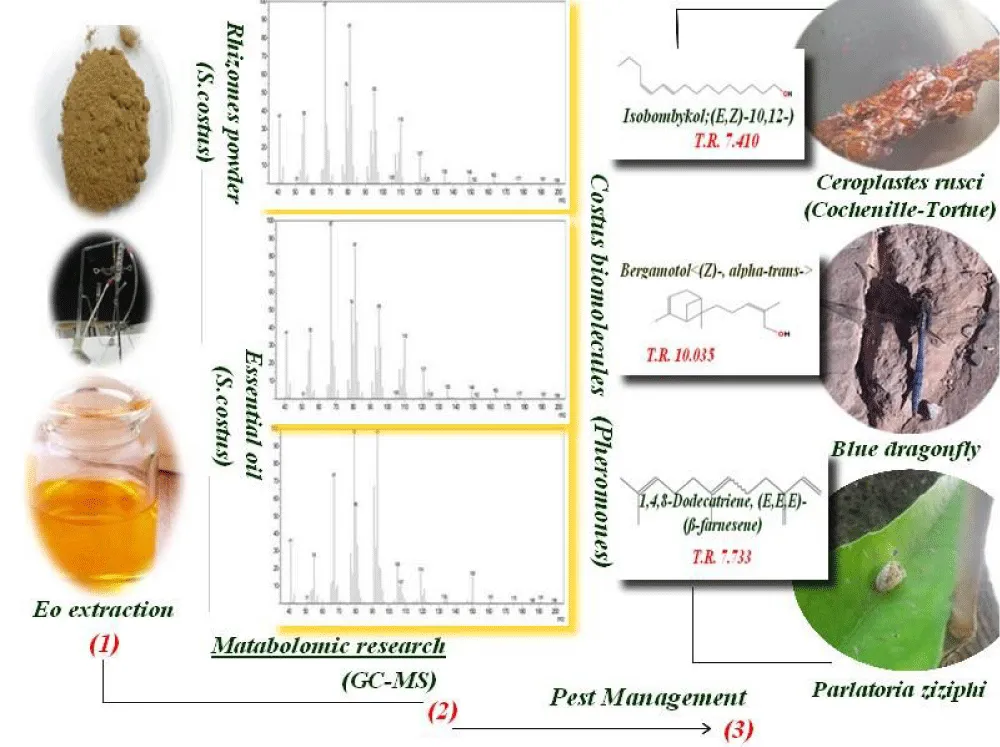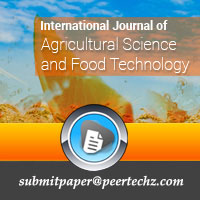International Journal of Agricultural Science and Food Technology
Metabolomics Investigation of Airborne Pheromones in Saussurea costus
Amina Meliani* and Fatima Djadouni
Faculty of Natural and Life Sciences, Mustapha Stambouli University, BP 763, 29000 Mascara, Algeria
Cite this as
Meliani A, Djadouni F. Metabolomics Investigation of Airborne Pheromones in Saussurea costus. Int J Agric Sc Food Technol. 2024;10(4):165-168. Available from: 10.17352/2455-815X.000221Copyright License
© 2024 Meliani A, et al. This is an open-access article distributed under the terms of the Creative Commons Attribution License, which permits unrestricted use, distribution, and reproduction in any medium, provided the original author and source are credited.The metabolomics approach as one of the important tools of Metabolomics has provided a powerful motivation for scientists to combine data generated from extracted compounds to create a more holistic understanding of pest management. Its application allows us to identify the entire profile of detectable metabolites contained in Essential oil anti-insects as an environmentally friendly alternative. Focusing on plant protection insecticides, and leading to its substitution, pheromones found in the Costu essential oils (EOs) may exert beneficial effects on pest management.
Dear Editor,
It was with great interest that we read the review article entitled “Natural and Synthetic Repellents for Pest Management of the Storage Mite Tyrophagus putrescentiae (Schrank) (Sarcoptiformes: Acaridae)”, [1]. We truly thank Naomi Manu and colleagues for this successful research article.
With the need for a sustainable agroecosystem, pest management is becoming imperative. Nowadays, it is known that essential oils are potent molecules with high potential for plant protection. These advantages have encouraged scientists to intensively screen for the plant’s biomolecules as promising candidates for pest management to replace currently used chemical pesticides. The application of such technology for the removal of these insects has received much attention and led to the development of effective, economical, and environmentally friendly technologies. The omics approaches such as metabolomics have provided a powerful motivation for scientists to combine data generated from extracted compounds to create a more holistic understanding of cells, and organisms. Furthermore, the combination of HPLC–MS, GC–MS, and behavioural bioassays as part of targeted metabolomics has become a revolutionary practice in pheromone research and has proven a tremendous success in pest management (Figure 1).
Furthermore, analyses of pheromone gland extracts using Gas Chromatography (GC) equipped with an electroantennographic detector (GC-EAD) and GC combined with Mass Spectrometry (GC–MS) have been used for the identification of several pheromone components [2].
In the present contribution, we are highlighting how Plant biomolecules present natural repellents for pest management and can be applied in a manner that minimizes risks to human health and the environment.
Unsurprisingly, there has been a growing interest in pheromone research in the face of the onslaught of various biotic factors. It has been shown that the essential oils of aromatic plants have been used in pest management strategies due to their repellent effects on target insects [3]. Consequently, the application of these technologies depends essentially on understanding the full mechanism of their synthesis and their target action. An increased understanding of these strategies has driven a revolution that is now, more than ever, involving known and specific biomolecules.
It is interesting to note that hundreds of pheromones and other semiochemicals were identified and used for monitoring insect abundance and attack [4]. These semiochemical compounds are able to mediate interactions either between individuals of the same species (pheromones) or across varied biological entities (allelochemicals) [5]. These natural products are increasingly efficient for a long-term reduction of insect populations. When encountering biotic and abiotic stresses, plants are able to adjust various biological activities where the synthesis of hormones is the best way. According to transduction distances and cell-cell neighbouring, three types of signaling processes are known (1) endocrine (2) paracrine, and (3) autocrine [6].
The idea of using species-specific behavior-modifying chemicals for the management of noxious insects (insect vectors of diseases in agriculture, horticulture, forestry, and stored products) has been a driving ambition through five decades of pheromone research [4].
Furthermore, the pest management paradigm has undergone an intentional shift from calendar-based, broad-spectrum insecticide applications [5]. Considerable interest has been gained in the development of alternative pest management strategies. Nowadays, attention is directed toward the use of plant biomolecules or essential oils as novel biotools.
Essential oils are used with known therapeutic properties. Nevertheless, they have other biological activities that make them able to be used as pesticides [7,8]. Essential oils act as chemical cues with an elicit effect on the behavioural responses of other organisms. Thus, the use of essential oils has steadily increased in pest management and offers an attractive alternative to replace chemical pesticides. In this letter, we describe the presence of three pheromones in the essential oil of Saussurea costus. Besides their broad-spectrum properties, other molecules can be used in pest management.
Finally, case studies are presented in which certain essential oils contain many molecules with pheromone properties. Furthermore, certain compounds with such properties have not been reported previously in this essential oil. The primary purpose of this letter is to assemble the available information concerning these pheromones. The primary outcome of GC–MS analysis done in 2020 is the presence of certain molecules not reported anywhere in the essential oil S. costus.
The Costus oil was subjected to GC-MS analysis using a Hewlett-Packard GC-MS system (GC: 5890 séries II, MSD 5972) and was identified by comparison with the NIST Mass Spectrometry Data Center and Wiley 8.0 MS library. The separation of oil into fractions led to the identification of other important components with pheromone properties such 10, 12-Hexadecadien-1-Ol (Isobombykol) (2.3%) and 1,4,8-Dodecatriene, (E,E,E)- (β-farnesene (0.97%). Furthermore, we found an important chimiotactif attractant (thunbergol (0.22%). The roles of specific metabolites can be elucidated via the omics approaches [9].
A previous study by Xu, et al. [10] found that sex pheromone reception in male moths is highly selective with a panel of bombykol analogs.
The β-farnesene is an alarm pheromone in many aphid species (Hemiptera: Aphididae) [11]. Widely used for insect communication. As an acyclic sesquiterpenes alkene, β-farnesene was common to green apple and some higher animals [12]. Furthermore, this pheromone is released by plants when damaged by a predator which warns other individuals that there is a danger. The alarm response of aphids to (E)-β-farnesene has been investigated in Jing-Gong, et al. [13] study, where forty-one aphid species responded to (E)-β-farnesene doses. It has been concluded that the response of aphids to (E)-β-farnesene was related to host-plant species. Present in many essential oils (Torreya taxifolia, Larix leptolepis, Robinia pseudoacacia, Medicago sativa, Chamomilla recutita, Vitis vinifera, Cannabis sativa, and Mentha × piperita [14], (E)-b-Farnesene is produced by socially dominant male mice, by bees [15], by several genera of ants [16] and other reported insects [17].
Noteworthy, Terpenes like Bergamotol < (Z)-, alpha-trans-> (α-trans-Bergamotenol) were detected in the essential oil of Saussurea costus (0.51%). The presence of this molecule has not been discussed widely in the chemotype of Saussurea costus. The Bergamotenes, are important bioactive compounds derived from the EOs of various plant species. Bergamotenes attract predators; as a result, plants are able to defend themselves against attack by herbivorous insects.
The results of Kheloul, et al. [3] indicate a dose-dependent trade-off between attractive and plant-derived repellent volatiles. The utility of pheromones in enhancing the propagation of entomopathogenic control agents has received considerable attention [18,19]. Furthermore, pheromone-baited traps are used for monitoring insecticide resistance in pest populations [20]. As described above, the valorization of such volatile molecules may influence their potential use in alternative pest management strategies. There is still a great deal to be learnt about the uses of essential oils of aromatic plants in pest management. When we know more about each specific action on the target insect, for example, the actions of some essential oils will probably be better understood. Based on the data published so far, pheromones produced by plants may exert beneficial effects on pest management, leading to a substitution of conventional insecticides. These futuristic green insecticides present cost-effective technical solutions for sustainable insect management.
- Manu N, Schilling MW, Phillips TW. Natural and synthetic repellents for pest management of the storage mite Tyrophagus putrescentiae (Schrank) (Sarcoptiformes: Acaridae). Insects. 2021;12(8):711. Available from: https://doi.org/10.3390/insects12080711
- Naka H, Horie Y, Mochizuki F, Le Van V Ang, Amamoto Masanobu Y, Saito T,et al. Identification of the sex pheromone secreted by Synanthedon hector (Lepidoptera: Sesiidae). Appl Entomol Zool. 2008;43(4):467-74. Available from: https://doi.org/10.1303/aez.2008.467
- Kheloul L, Kellouche A, Bréard D, Gay M, Gadenne C, Anton S. Trade-off between attraction to aggregation pheromones and repellent effects of spike lavender essential oil and its main constituent linalool in the flour beetle Tribolium confusum. Entomol Exp Appl. 2019;167:826-34. Available from: https://doi.org/10.1111/eea.12831
- Witzgall P, Kirsch P, Cork A. Sex pheromones and their impact on pest management. J Chem Ecol. 2010;36(1):80-100. Available from: https://doi.org/10.1007/s10886-009-9737-y
- Tewari S, Leskey TC, Nielsen AL, Piñero JC, Rodriguez-Saona CR. Use of pheromones in insect pest management, with special attention to weevil pheromones, in integrated pest management: Current concepts and ecological perspective. In: Abrol DP, editor. Integrated Pest Management: Current Concepts and Ecological Perspective. Elsevier Science Publishers; 2014;141-68. Available from: https://doi.org/10.1016/B978-0-12-398529-3.00010-5
- Yu H, Wang I, Irving HR. Developing a model of plant hormone interactions. Plant Signal Behav. 2011;6(4):94-500. Available from: https://doi.org/10.4161/psb.6.4.14558
- Burfield T, Reekie SL. Mosquitoes, malaria, and essential oils. Int J Aromather. 2005;15:30-41. Available from: http://dx.doi.org/10.1016/j.ijat.2004.09.013
- El Tamer MK. Molecular regulation of plant monoterpene biosynthesis in relation to fragrance. Wageningen University; 2002. Available from: https://www.researchgate.net/publication/40155011_Molecular_regulation_of_plant_monoterpene_biosynthesis_in_relation_to_fragrance
- Desika J, Yogendra K, Hepziba SJ, Patne N, Vivek BS, Ravikesavan R, et al. Exploring metabolomics to innovate management approaches for fall armyworm (Spodoptera frugiperda [J.E. Smith]) infestation in maize (Zea mays L.). Plants. 2024;13:2451. Available from: https://doi.org/10.3390/plants13172451
- Pingxi XU, Hooper AM, Pickett JA, Leal WS. Specificity determinants of the silkworm moth sex pheromone. PLoS One. 2012;7(9):e44190. Available from: https://doi.org/10.1371/journal.pone.0044190
- Francis F, Vandermoten S, Verheggen F, Lognay G, Haubruge E. Is the (E)-β-farnesene the only volatile terpenoid in aphids? J Appl Entomol. 2005;129(1):6-11. Available from: https://doi.org/10.1111/j.1439-0418.2005.00925.x
- Hazekamp A, Tejkalová K, Papadimitriou S. Cannabis: From cultivar to chemovar II - A metabolomics approach to cannabis classification. Cannabis Cannabinoid Res. 2016;1(1):202-215. Available from: https://doi.org/10.1089/can.2016.0017
- Jing-Gong X, Feng Z, Yu-Ling F, Wei K. Behavioural response of aphids to the alarm pheromone component (E)-β-farnesene in the field. Physiol Entomol. 2002;27(4):307-311. Available from: https://doi.org/10.1046/j.1365-3032.2002.00302.x
- Crock J, Wildung M, Croteau R. Isolation and bacterial expression of a sesquiterpene synthase cDNA clone from peppermint (Mentha x piperita, L.) that produces the aphid alarm pheromone (E)-β-farnesene. Proc Natl Acad Sci USA. 1997;94(24):12833-12838. Available from: https://doi.org/10.1073/pnas.94.24.12833
- Fernandes A, Duffield RM, Wheeler JW, Laberge WE. Chemistry of the Dufour's gland secretions of North American andrenid bees (Hymenoptera: Andrenidae). J Chem Ecol. 1987;7(2):453-463. Available from: https://doi.org/10.1007/bf00995768
- Ollet DG, Morgan ED, Attygalle AB, Billen JPJ. The contents of the Dufour gland of the ant Harpagoxenus sublaevis Nyl. (Hymenoptera: Formicidae). Z Naturforsch C. 2014;42:141-146. Available from: http://dx.doi.org/10.1515/znc-1987-1-223
- Beirne BP, Young DA. The North American species of Cicadula (Homoptera: Cicadellidae). Can Entomol. 1953;85(1):215-226.
- Kreutz J, Zimmermann G, Vaupel O. Horizontal transmission of the entomopathogenic fungus Beauveria bassiana among the spruce bark beetle, Ips typographus (Col., Scolytidae) in the laboratory and under field conditions. Biocontrol Sci Technol. 2004;14:837-848. Available from: http://dx.doi.org/10.1080/788222844
- Tinzaara W, Gold CS, Dicke M, Van Huis A, Ragama PE, Nankinga CM, et al. The use of aggregation pheromone to enhance dissemination of Beauveria bassiana for the control of the banana weevil in Uganda. Biocontrol Sci Technol. 2007;17:111-124. Available from: https://doi.org/10.1080/09583150600937089
- Sauphanor B, Brosse V, Bouvier JC, Speich P, Micoud A, Martinet C. Monitoring resistance to diflubenzuron and deltamethrin in French codling moth populations (Cydia pomonella). Pest Manag Sci. 2000;56:74-82. Available from: http://dx.doi.org/10.1002/(SICI)1526-4998(200001)56:1%3C74::AID-PS96%3E3.0.CO;2-C
Article Alerts
Subscribe to our articles alerts and stay tuned.
 This work is licensed under a Creative Commons Attribution 4.0 International License.
This work is licensed under a Creative Commons Attribution 4.0 International License.



 Save to Mendeley
Save to Mendeley
